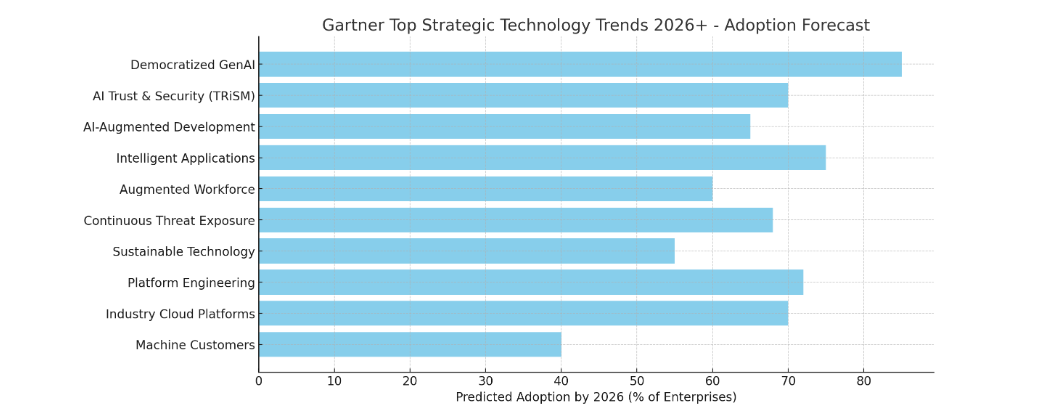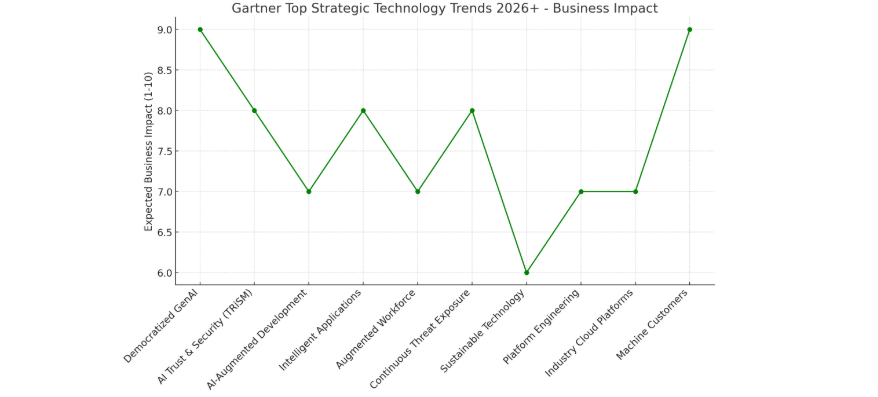Blog
Key Gartner Predictions & Strategic Tech Trends Toward 2026
Below are the major trends Gartner has identified, along with what they mean and what to watch out for.
| Trend | What It Means / Why It Matters | Key Predictions or Metrics |
|---|---|---|
| Democratized Generative AI | GenAI (large language models, pretrained models, etc.) becoming widely accessible — not only for specialized R&D or large firms, but integrated across many business functions. Easier to use, cheaper, embedded in apps. | By 2026, > 80% of enterprises will have used GenAI APIs and/or have GenAI-enabled applications in production. |
| AI Trust, Risk & Security Management (TRiSM) | As AI becomes pervasive, issues like bias, misuse, data privacy, model security, drift, ethical concerns become more pressing. Tools, frameworks, governance will be needed. | By 2026, enterprises applying robust TRiSM controls will dramatically reduce faulty or illegitimate information and improve decision accuracy (eliminate up to ~80% faulty info). |
| AI-Augmented Development | Using AI to help with coding, testing, design, or other software engineering tasks — boosting developer productivity, reducing mundane work, etc. | Increasing reliance on tools that help with auto-coding, test generation, etc. Gartner predicts many engineering orgs will adopt these (this is already underway). |
| Intelligent Applications | Applications will have more built-in intelligence (adaptivity, autonomy, responding dynamically to users, using ML, vector stores, etc.). These will move beyond static or rule-based apps. | More apps will use adaptive intelligence, contextual behaviours; richer user experience with less manual configuration. |
| Augmented-Connected Workforce | Enhancing the human workforce with connected tools, insights, guidance; enabling upskilling, reducing time to competence; supporting well-being, etc. Hybrid work, data-driven HR/Work aspects. | By 2027, about 25% of CIOs will use initiatives to reduce time to competency by ~50% for key roles. |
| Continuous Threat Exposure Management (CTEM) | Not just static security / periodic audits but ongoing, holistic view of exposures, vulnerabilities, adaptability to threat vectors and business changes. | Organizations that prioritize CTEM are predicted to achieve ~2/3 reductions in breaches by 2026. |
| Sustainable Technology | Tech choices evaluated also on environmental, social, governance (ESG) impact. Energy efficiency, cloud usage, carbon emissions, circular economy, etc. Sustainable tech embedded in decisions, not just a checkbox. | By 2027, ~25% of CIOs will have their compensation tied to sustainable technology impact. |
| Platform Engineering | Building internal platforms / developer tools / services to streamline development, reduce duplication, enable self-service, reduce maintenance burden, improve velocity & developer experience. | More organizations will set up “platform engineering” teams. Gartner sees this becoming a common discipline. |
| Industry Cloud Platforms | Cloud offerings tailored to specific industries: combining SaaS, PaaS, IaaS, domain-specific capabilities, compliance, etc. So that rather than generic cloud, more vertical-specialised platforms. | By 2027, Gartner predicts more than 70% of enterprises will use industry cloud platforms to accelerate business initiatives. |
| Machine Customers (‘Custobots’) | Increasing number of non-human agents / connected devices acting as customers — making autonomous purchase or negotiation decisions; IoT + intelligent agents etc. | By 2028, ~15 billion connected products that could behave as customers. Could generate trillions in revenue. |
Gartner’s Top Strategic Technology Trends for 2026 and beyond


Here are two visualizations that are created based on Gartner’s Top Strategic Technology Trends for 2026 and beyond:
- Adoption Forecast (by 2026) – percentage of enterprises expected to adopt each trend.
- Business Impact Ratings – estimated strategic importance (1–10 scale).